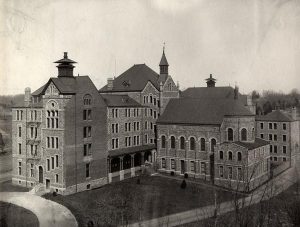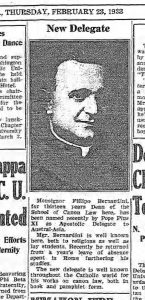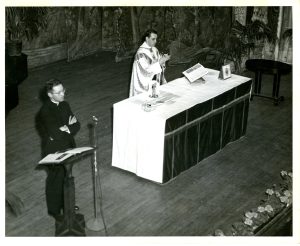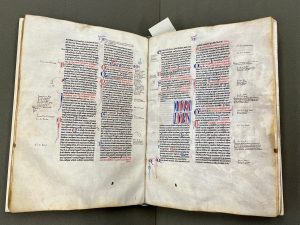
September 26, 1923 marked the opening of lectures for the 1923-24 academic year at Catholic University. Students hustled between classes in McMahon and Caldwell Halls, on what may have seemed a typical start to a new semester. But on this particular day, a new School opened on campus – the School of Canon Law.
Since the very start of the University, canon law (the laws governing the conduct of the Catholic Church and its members) has been a subject taught within the halls of Caldwell Hall. But the current School of Canon Law dates back to only 1923. Prior to that year from 1890-1923, it existed as a department under the auspices of the School of Sacred Sciences.
However, in the wake of the revision of canon law that resulted in the 1917 Code, a renewed interest in canonical studies emerged. (1) Beginning in 1921, University administrators began petitioning Rome for the creation of a new campus school dedicated to canon law. On April 11, 1923 at their spring meeting, the University’s Board of Trustees – with the blessing of the Holy See – authorized the elevation of the existing Department of Canon Law into a distinct School of Canon Law, with the first classes opening later that fall. (2)

The initial faculty of the new School included five scholars of canon law and one on international law: Msgr. Filippo Bernardini; Rev. Valentine Theodore Schaaf, OFM; Rev. Hubert Louis Motry; Rev. Francesco Lardone; and, Manoel de Oliveira Lima (the donor of the Oliveira Lima Library and international law professor). A native Italian, Msgr. Bernardini had been teaching canon law on the campus since 1914, and he had been involved in the 1917 codification of canon law. Thus, he was a natural pick to be the inaugural dean of the new School. During his tenure, he advocated for the expansion of the School’s library resources, including a dedicated space in the then-new Mullen Library that continues to exist to this day.
In 1933, Msgr. Bernardini was made the Apostolic Nuncio to Australia and left the University. Later, he would be made Apostolic Nuncio to Switzerland in 1935, a position he served in during the Second World War. In this post, he would serve as an intermediary between Jewish and Catholic organizations in communicating the situation of and aiding Jewish refugees fleeing the Holocaust. After the war, he served briefly as the Secretary of the Congregation for Propagation of the Faith from 1953-54.
Back in DC, the School of Canon Law continued with its expansion after Bernardini’s departure. First, Rev. Schaaf served as dean from 1933-1937, with Rev. Hubert Motry following as dean from 1937 until his death in 1952. An Ohio native and graduate of Catholic University, Motry’s tenure was consequential in the founding of the Canon Law Society of America and the School’s journal, The Jurist, in 1939 and 1941, respectively. (This journal continues to be published on campus to this day.)
In 1940, the School also accepted its first lay professor of canon law, Stephan Kuttner. A celebrated scholar of medieval legal history and canon law, Kuttner fled his native Germany in the 1930s due to his family’s Jewish ancestry. After initially teaching in Rome, Kuttner and his family relocated to Catholic University, where he taught from 1940-1964. (He later taught at the University of California – Berkeley.) Kuttner’s tenure was instrumental in establishing a strong medieval studies presence in both the School of Canon Law and the broader campus.

The 1960s and 70s witnessed another period of change for the School, as the Church reflected on the reforms of the Second Vatican Council. Msgr. Frederick McManus, a Boston-era priest and Catholic University alumnus, taught and worked in the administration on campus from 1958-1997, including serving as the dean of the School of Canon Law from 1967-1973. A major figure in post-Vatican II reform and liturgical studies, McManus was also an accomplished canonist and leader in ecumenical dialogues.
Towards the end of McManus’s tenure and in time for the School’s fiftieth anniversary, the first women were admitted into the canon law program in 1973: Sr. M. Davilyn Ah-Chick, OFM; Sr. Judith Anne Bernhiser, OSU; and, Sr. Lucy Vasquez, OP. (3) The latter two would go on to become the first American women to be canon lawyers. Sr. Vasquez would also be elected in 1990 as the first woman to lead the Canon Law Society of America.
The year 1973 also witnessed the School of Canon Law being folded within the School of Religious Studies. This arrangement would last until 2003, when the two programs would be split again into the School of Canon Law and the School of Theology and Religious Studies. CatholicU’s School of Canon Law remains the sole School dedicated to canonical studies in the United States.

Special Collections has a number of collections related to the history of the School and the study of canon law, including the papers of Msgr. Frederick McManus and Rev. Hubert Motry. Our Rare Book collection also houses a vast array of canonical sources, dating from the eleventh to twentieth centuries. Contact us for more information on accessing these materials: lib-archives@cua.edu
(1) “Canon Law: 50 Years of Service”, Envoy Clergy 1, no. 6: 2
(2) Joseph Neusse, The Catholic University of America: A Centennial History. Catholic University Press, Washington, DC: 1990, 217.
(3) “Nuns in Canon Law May Be Pioneers of New Trend,” Envoy 2, no. 2 (August 1973): 4.
